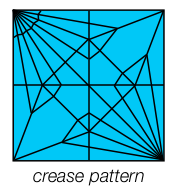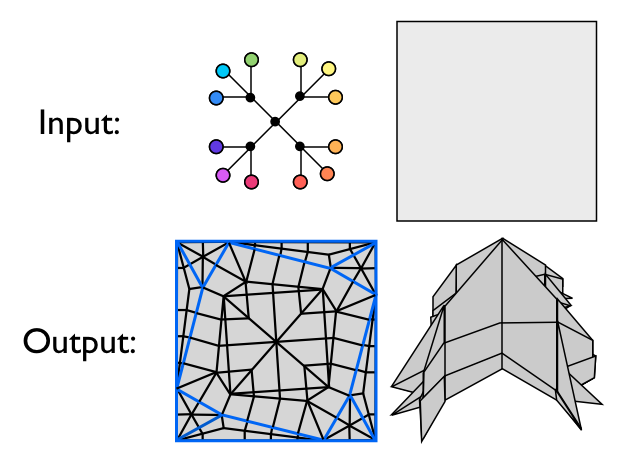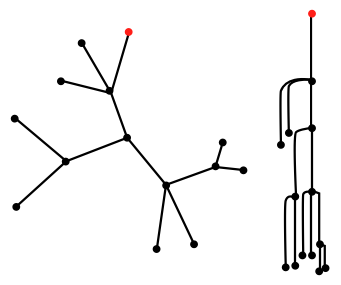A base
for a crease pattern is a folding of the paper along the crease edges
to realize a 3D state. A base can be defined mathematically as a mapping of the vertices
of the crease pattern into 3D such that the base is isometric and isomorphic to the flat
crease pattern. In other words, the 3D structure preserves the combinatorics of the crease
pattern as well as the shape and metric of each of the faces.

Robert J. Lang further categorized two subsets of bases called projectable
and uniaxial in his paper "A Computational Algorithm for Origami Design." These
provide for a more strict form of base which Lang showed is amenable to an algorithmic
treatment.
A projectable base
is one in which all of the faces are perpendicular to
some common plane (typically the
xy-plane). The projection of the base onto
the orthogonal plane forms a geometric tree, which is called the
shadow tree.
The figure below depicts two different projectable bases with the same shadow tree. In
both bases, the gray plane is perpendicular to each of the orange faces of the base.
The left figure has an added property, however, that the intersection of the base with
the orthogonal plane is equal to its shadow tree.

A uniaxial base
is a projectable base where all the faces of the base lie on the same
side of the orthogonal plane, and the boundary of the paper is mapped exactly onto the shadow
tree. The figure below shows an example.
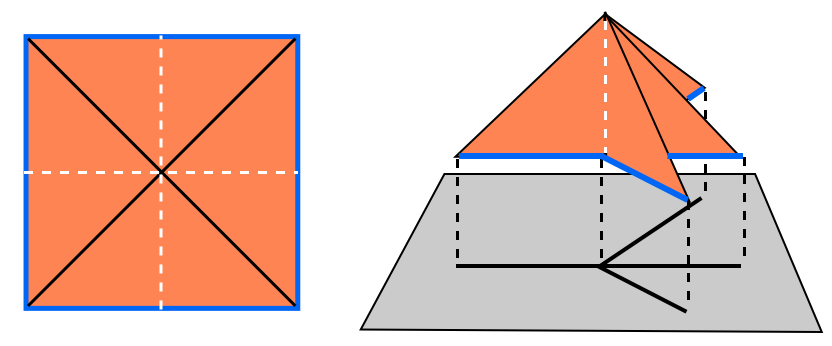
In this figure the crease pattern is shown on the left, and a uniaxial base for the crease
pattern is on the right. The orthogonal plane has been shifted downwards so that the shadow
tree is clearly visible. The boundary of the paper has been colored blue in both figures, and
the diagonal creases are shown in black while the horizontal and vertical creases are depicted
with a dotted white line. The reader can clearly see that the boundary of the polygon is folded
exactly onto the shadow tree.
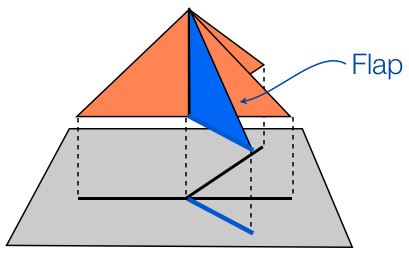
All of the faces that project to the same arc of the shadow tree are called a flap.
The uniaxial base in the figure above has four flaps, each of which two faces of the base
project to. In a uniaxial base, the internal nodes of the shadow tree correspond to "hinge" creases that
are perpendicular to the orthogonal plane. Rotations of shadow tree arcs correspond to rotations
of the flaps around the internal nodes correspond to rotations of the flaps about the corresponding
hinge crease. The figure below shows two uniaxial bases for the same crease pattern as above. These
bases only differ by rotation around the hinge creases.
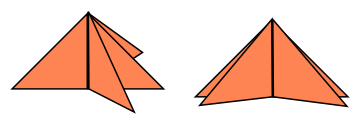
Two uniaxial bases with the same crease pattern.
The term uniaxial is used, because if the shadow tree arcs are aligned, as in the figure below,
the boundary of the paper is aligned along a single axis.

If the shadow tree of a uniaxial base aligns, then the boundary of the paper aligns along a single axis.

 Crease Patterns
Crease Patterns
